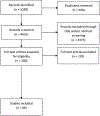Postpartum Visit Attendance in the United States: A Systematic Review
- PMID: 35304034
- PMCID: PMC9283204
- DOI: 10.1016/j.whi.2022.02.002
Postpartum Visit Attendance in the United States: A Systematic Review
Abstract
Introduction: Adequate postpartum care, including the comprehensive postpartum visit, is critical for long-term maternal health and the reduction of maternal mortality, particularly for people who may lose insurance coverage postpartum. However, variation in previous estimates of postpartum visit attendance in the United States makes it difficult to assess rates of attendance and associated characteristics.
Methods: We conducted a systematic review of estimates of postpartum visit attendance. We searched PubMed, CINAHL, PsycInfo, and Web of Science for articles published in English from 1995 to 2020 using search terms to capture postpartum visit attendance and use in the United States.
Results: Eighty-eight studies were included in this analysis. Postpartum visit attendance rates varied substantially, from 24.9% to 96.5%, with a mean of 72.1%. Postpartum visit attendance rates were higher in studies using patient self-report than those using administrative data. The number of articles including an estimate of postpartum visit attendance increased considerably over the study period; the majority were published in 2015 or later.
Conclusions: Our findings suggest that increased systematic data collection efforts aligned with postpartum care guidelines and attention to postpartum visit attendance rates may help to target policies to improve maternal wellbeing. Most estimates indicate that a substantial proportion of women do not attend at least one postpartum visit, potentially contributing to maternal morbidity as well as preventing a smooth transition to future well-woman care. Estimates of current postpartum visit attendance are important for informing efforts that seek to increase postpartum visit attendance rates and to improve the quality of care.
Copyright © 2022 Jacobs Institute of Women's Health, George Washington University. Published by Elsevier Inc. All rights reserved.
Figures


Similar articles
-
The impact of Medicaid expansion on postpartum health care utilization among pregnant women with opioid use disorder.Subst Abus. 2019;40(3):371-377. doi: 10.1080/08897077.2019.1573209. Epub 2019 Mar 25. Subst Abus. 2019. PMID: 30908175 Free PMC article.
-
Mapping the intersection of social determinants of health, postpartum visit attendance, and pregnancy-related deaths: A scoping review.Public Health Nurs. 2024 May-Jun;41(3):374-382. doi: 10.1111/phn.13290. Epub 2024 Jan 31. Public Health Nurs. 2024. PMID: 38296814
-
Correlates of Postpartum Visits Among Medicaid Recipients: An Analysis Using Claims Data from a Managed Care Organization.J Womens Health (Larchmt). 2018 Jun;27(6):836-843. doi: 10.1089/jwh.2016.6137. Epub 2018 Feb 16. J Womens Health (Larchmt). 2018. PMID: 29451839
-
Health Insurance Coverage and Postpartum Outcomes in the US: A Systematic Review.JAMA Netw Open. 2023 Jun 1;6(6):e2316536. doi: 10.1001/jamanetworkopen.2023.16536. JAMA Netw Open. 2023. PMID: 37266938 Free PMC article.
-
Predictors of Non-Attendance to the Postpartum Follow-up Visit.Matern Child Health J. 2016 Nov;20(Suppl 1):22-27. doi: 10.1007/s10995-016-2184-9. Matern Child Health J. 2016. PMID: 27562797
Cited by
-
Increasing Postpartum Primary Care Engagement through Default Scheduling and Tailored Messaging: A Randomized Clinical Trial.medRxiv [Preprint]. 2024 May 1:2024.01.21.24301585. doi: 10.1101/2024.01.21.24301585. medRxiv. 2024. Update in: JAMA Netw Open. 2024 Jul 1;7(7):e2422500. doi: 10.1001/jamanetworkopen.2024.22500. PMID: 38633772 Free PMC article. Updated. Preprint.
-
Medicaid-covered health care visits during the postpartum year: Variation by enrollee characteristics and state.Health Aff Sch. 2025 Jan 30;3(2):qxaf019. doi: 10.1093/haschl/qxaf019. eCollection 2025 Feb. Health Aff Sch. 2025. PMID: 39949825 Free PMC article.
-
Barriers to postpartum health and opinions on a postpartum peer navigator program amongst refugee women resettled in California.BMC Pregnancy Childbirth. 2025 Mar 29;25(1):372. doi: 10.1186/s12884-025-07479-2. BMC Pregnancy Childbirth. 2025. PMID: 40158108 Free PMC article.
-
The Relationship Between Provider and Patient Racial Concordance and Receipt of Postpartum Care.J Racial Ethn Health Disparities. 2024 Sep 13:10.1007/s40615-024-02164-0. doi: 10.1007/s40615-024-02164-0. Online ahead of print. J Racial Ethn Health Disparities. 2024. PMID: 39269565
-
Racial/Ethnic Disparities in Postpartum Health Insurance Coverage Among Rural and Urban U.S. Residents.J Womens Health (Larchmt). 2022 Oct;31(10):1397-1402. doi: 10.1089/jwh.2022.0169. Epub 2022 Aug 30. J Womens Health (Larchmt). 2022. PMID: 36040353 Free PMC article.
References
-
- Attanasio L, Ranchoff B, & Geissler K (2021). Perceived discrimination during the childbirth hospitalization and postpartum visit attendance and content: Evidence from the Listening to Mothers in California survey. PLOS One. https://doi.org/10.1371/journal.pone.0253055 - DOI - PMC - PubMed
-
- Daw JR, Kozhimannil KB, & Admon LK (2019). High Rates of Perinatal Insurance Churn Persist After the ACA. Retrieved October 18, 2021, from https://www.healthaffairs.org/do/10.1377/hblog20190913.387157/full/ - DOI
Publication types
MeSH terms
Grants and funding
LinkOut - more resources
Full Text Sources
Medical

